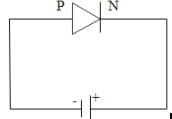
What is biasing a diode? Write two differences between the two kinds of biasing.
Answer
586.2k+ views
Hint: A p-n junction diode can be connected to battery in two ways. One by connecting the positive terminal of the battery to the p-side and negative to the n-side and another by connecting the negative terminal of the battery to the p-side and positive terminal to the n-side.
Complete step-by-step answer:
A p-n junction diode is an electronic device made of semiconductors where we have two slabs joined with each other. One is a p-type semiconductor and the other is an n-type semiconductor. Following diagram shows the symbol for a p-n junction diode.
Biasing of a diode is defined as how the diode is being connected to the battery. A diode has two terminals which can be connected to a battery. Biasing implies which terminal of the battery is being connected to which side of the diode.
There are two ways in which we can do biasing:
1.)Forward biasing:
In forward biasing, we attach the positive terminal of the battery to the p-side of the diode while the negative terminal of the battery is joined with the n-side of the diode.

The charge carriers are drifted towards the opposite terminals moving across the diode leading to decrease in width of depletion layer. Large amount of current can flow in forward biased diodes.
2.)Reverse biasing:
In reverse biasing, we attach the negative terminal of the battery to the p-side of the diode while the positive terminal of the battery is joined with the n-side of the diode.

The charge carriers drift towards the opposite terminals moving away from the depletion layer leading to an increase in width of the depletion layer. Very small amount of current can flow in forward biased diodes.
Note:
1.) A reverse biased p-n junction diode is not subjected to high voltages as it can lead to breakdown which can permanently damage the diode.
2.) It is possible to use certain heavily doped diodes to be used in reverse biased configuration.
Complete step-by-step answer:
A p-n junction diode is an electronic device made of semiconductors where we have two slabs joined with each other. One is a p-type semiconductor and the other is an n-type semiconductor. Following diagram shows the symbol for a p-n junction diode.
Biasing of a diode is defined as how the diode is being connected to the battery. A diode has two terminals which can be connected to a battery. Biasing implies which terminal of the battery is being connected to which side of the diode.
There are two ways in which we can do biasing:
1.)Forward biasing:
In forward biasing, we attach the positive terminal of the battery to the p-side of the diode while the negative terminal of the battery is joined with the n-side of the diode.

The charge carriers are drifted towards the opposite terminals moving across the diode leading to decrease in width of depletion layer. Large amount of current can flow in forward biased diodes.
2.)Reverse biasing:
In reverse biasing, we attach the negative terminal of the battery to the p-side of the diode while the positive terminal of the battery is joined with the n-side of the diode.

The charge carriers drift towards the opposite terminals moving away from the depletion layer leading to an increase in width of the depletion layer. Very small amount of current can flow in forward biased diodes.
Note:
1.) A reverse biased p-n junction diode is not subjected to high voltages as it can lead to breakdown which can permanently damage the diode.
2.) It is possible to use certain heavily doped diodes to be used in reverse biased configuration.
Recently Updated Pages
Master Class 12 Economics: Engaging Questions & Answers for Success

Master Class 12 Maths: Engaging Questions & Answers for Success

Master Class 12 Biology: Engaging Questions & Answers for Success

Master Class 12 Physics: Engaging Questions & Answers for Success

Basicity of sulphurous acid and sulphuric acid are

Master Class 12 Business Studies: Engaging Questions & Answers for Success

Trending doubts
What are the major means of transport Explain each class 12 social science CBSE

Which are the Top 10 Largest Countries of the World?

Draw a labelled sketch of the human eye class 12 physics CBSE

How much time does it take to bleed after eating p class 12 biology CBSE

Explain sex determination in humans with line diag class 12 biology CBSE

Differentiate between homogeneous and heterogeneous class 12 chemistry CBSE




